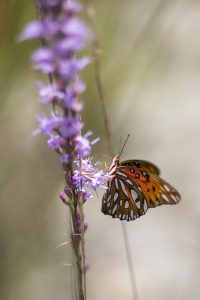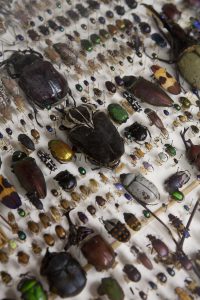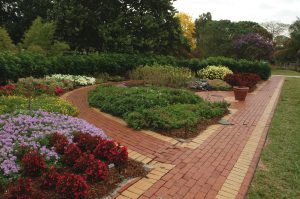Hello Avid Readers and welcome back! This week we will be celebrating slightly in advance of Pollinator Week. Our vegetable and flower gardens serve as a point of pride for many of us green thumbs. We want to protect our veggies from pests, but it is important to keep our pollinator friends in mind. So, come along for the ride as I describe how to safely use pesticides with reduced risk to pollinators.
Who Are Our Pollinators?
There are many different pollinators in our Florida gardens. Birds and bats are responsible for some of this but most of them are insects. You are probably aware that bees and wasps are one of the biggest pollinator groups. Did you know honey bees are not native to the Americas, and that there are 3600 species of bees native to the US and Canada?! Most of these bees are solitary. This means they take care of their own small nest rather than working together to create a large hive. Bumble bees are a great example because they are great at pollinating our tomatoes and peppers!
Some of our pollinators get a bad reputation for their less than friendly behavior. Wasps fall into this group. I must say though, that these guys and gals are really misunderstood! Most wasps are hunters who would be happy to leave humans alone. They are beneficial insects since they eat a lot of pests. While they do play a role in pollination, it’s mostly accidental as they move amongst flowers while hunting.

Butterflies and moths are also important pollinators. Adult butterflies feed on nectar from flowers and transport pollen in the process. Some moths are vital to the pollination of night-blooming flowers like cereus cactus and jasmine. Caterpillars often eat the same plant that the adult feeds from. However, many caterpillars are foliage or leaf feeders. This can cause some problems we’ll discuss later.
Another group people are not generally fans of are flies. This is actually one of the most diverse groups of insects and many are beneficial! The larvae of aquatic flies serve as food for fish. Migratory birds also enjoy making a meal out of flies and this is important to their lifecycle. Flies are also pollinators and we can thank them for our apples, mangoes, and cashews.

One of every four described species is a beetle. Wow! Since this group is so diverse they fill a huge array of roles in the environment. It is suspected they may have been the first of the insect pollinators (according to the fossil record). In Florida, we thank our beetles for pollinating the beautiful magnolias and water lilies among other things.
What’s the Challenge?
Many of the products that kill insect pests will kill pollinators too. This is because insecticides target insect physiology, or how their body works. So, they aren’t very specific when it comes to different types of caterpillars. Pesticides that directly contact pollinators may kill them. This can include some herbicides and fungicides too. Residues, or leftover pesticide, on our plants can also kill them, so be careful when using a pyrethroid or Bt spray. These insecticides can hang around for a bit and insects that contact them or consume the Bt could die. Systemic insecticides are insecticides that go into the plant and stay there. This includes neonicotinoids which can also go into the plants nectar and pollen.
Besides pesticides themselves, pollinators can be in danger if they have no place to live. Reducing the native habitat, such as things we may consider weeds, will reduce pollinator food sources. Having a pristine turf lawn provides no food for pollinators. It is important to remember the diversity in our pollinators and that they need a diverse array of plants to feed on.
What Can I Do in My Garden?
Consider the interactions that will occur between pesticides and pollinators in your garden. A little planning can go a long way. Creating a habitat for pollinators that you don’t intend to manage, such as a butterfly garden aside from your vegetable garden, can create a safe space for the little buggers. These gardens also add diversity and beauty to the area!

For your garden or plants that you do want to manage, use Integrated Pest Management (IPM). There is a lot of information out there on how to develop a plan to target pests while reducing impacts on beneficial organisms like pollinators. I have provided links to a few below under “Additional Information”. Most mention the following as takeaways:
- Plant the right plant in the right place
- Time planting to reduce seasonal garden pests
- If sprays are needed
- Read the label
- Use the most targeted pesticide
- Spray at a time when plants are not flowering
- Spray when pollinators are not active
Summary
There are many different species of pollinators and most of them are insects. Pesticides and pollinators are a growing topic because we have become more aware of their overlap in the environment, and the negative impact of some of our pest management tools. Specifically, pollinators are in danger by being directly sprayed by pesticides, consuming systemic insecticides, coming in contact with pesticide residuals, or not having enough habitat in the first place. You can manage your plants or garden and protect pollinators by using IPM. Additionally, you can create habitat for pollinators by incorporating a butterfly garden or unmanaged area on your property.
Additional Materials
Minimizing Bee Exposure to Pesticides
References
Pollinator Information http://www.xerces.org/pollinator-conservation/about-pollinators
Bt as a Spray Insecticide https://www.lsuagcenter.com/profiles/lbenedict/articles/page1491496686765
Source: UF/IFAS Pest Alert
Note: All images and contents are the property of UF/IFAS.



